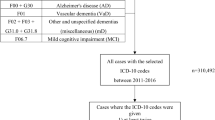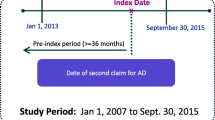Abstract
Dementia is increasing dramatically and imposes a huge burden on society. To date, there is a lack of data on the health status of patients with dementia in China. In an attempt to investigate the comorbidity burden of dementia patients in China at the national level, we enrolled 2,938 patients with Alzheimer’s disease (AD), vascular dementia (VaD), or other types of dementia, who were admitted to tertiary hospitals in seven regions of China from January 2003 to December 2012. The Charlson Comorbidity Index (CCI) was used to evaluate the comorbidity burden of the patients with dementia. Among these patients, 53.4% had AD, 26.3% had VaD, and 20.3% had other types of dementia. The CCI was 3.0 ± 1.9 for all patients, 3.4 ± 1.8 for those with VaD, and 3.0 ± 2.1 for those with AD. The CCI increased with age in all patients, and the length of hospital stay and daily expenses rose with age and CCI. Males had a higher CCI and a longer stay than females. Moreover, patients admitted in the last 5 years of the study had a higher CCI than those admitted in the first 5 years. We found that the comorbidity burden of patients with dementia is heavy. These findings provide a better understanding of the overall health status of dementia patients, and help to increase the awareness of clinicians and policy-makers to improve medical care for patients.
Similar content being viewed by others
References
Chan KY, Wang W, Wu JJ, Liu L, Theodoratou E, Car J, et al. Epidemiology of Alzheimer’s disease and other forms of dementia in China, 1990-2010: a systematic review and analysis. Lancet 2013, 381: 2016–2023.
Tabulation on the 2010 Population Census of the People’s Republic of China (http://www.stats.gov.cn/tjsj/pcsj/rkpc/6rp/indexch.htm), China Statistics Press, 201.
Pei JJ, Giron MS, Jia J, Wang HX. Dementia studies in Chinese populations. Neurosci Bull 2014, 30: 207–216.
Wu YT, Lee HY, Norton S, Chen C, Chen H, He C, et al. Prevalence studies of dementia in mainland china, Hong Kong and taiwan: a systematic review and meta-analysis. PLoS One 2013, 8: e66252.
Jia J, Wang F, Wei C, Zhou A, Jia X, Li F, et al. The prevalence of dementia in urban and rural areas of China. Alzheimers Dement 2014, 10: 1–9.
Callahan CM, Schubert CC. Dementia: The complexities of comorbidity in dementia. Nat Rev Neurol 2014, 10: 184–186.
Su F, Bai F, Zhang Z. Inflammatory cytokines and Alzheimer’s disease: A review from the perspective of genetic polymorphisms. Neurosci Bull 2016, 32: 469–480.
Pan X, Chen Z, Fei G, Pan S, Bao W, Ren S, et al. Long-term cognitive improvement after benfotiamine administration in patients with Alzheimer’s disease. Neurosci Bull 2016, 32: 591–596.
McKhann G, Drachman D, Folstein M, Katzman R, Price D, Stadlan EM. Clinical diagnosis of Alzheimer’s disease: report of the NINCDS-ADRDA Work Group under the auspices of Department of Health and Human Services Task Force on Alzheimer’s Disease. Neurology 1984, 34: 939–944.
Roman GC, Tatemichi TK, Erkinjuntti T, Cummings JL, Masdeu JC, Garcia JH, et al. Vascular dementia: diagnostic criteria for research studies. Report of the NINDS-AIREN International Workshop. Neurology 1993, 43: 250–260.
Charlson ME, Pompei P, Ales KL, MacKenzie CR. A new method of classifying prognostic comorbidity in longitudinal studies: development and validation. J Chronic Dis 1987, 40: 373–383.
Quan H, Sundararajan V, Halfon P, Fong A, Burnand B, Luthi JC, et al. Coding algorithms for defining comorbidities in ICD-9-CM and ICD-10 administrative data. Med Care 2005, 43: 1130–1139.
Austin PC, Grootendorst P, Anderson GM. A comparison of the ability of different propensity score models to balance measured variables between treated and untreated subjects: a Monte Carlo study. Stat Med 2007, 26: 734–753.
Austin PC. Balance diagnostics for comparing the distribution of baseline covariates between treatment groups in propensity-score matched samples. Stat Med 2009, 28: 3083–3107.
Alzheimer’s disease facts and figures. Alzheimers Dement 2010, 6: 158–194.
Chan KY, Wang W, Wu JJ, Liu L, Theodoratou E, Car J, et al. Epidemiology of Alzheimer’s disease and other forms of dementia in China, 1990–2010: a systematic review and analysis. The Lancet 2013, 381: 2016–2023.
He J, Gu D, Wu X, Reynolds K, Duan X, Yao C, et al. Major causes of death among men and women in China. N Engl J Med 2005, 353: 1124–1134.
Lozano R, Naghavi M, Foreman K, Lim S, Shibuya K, Aboyans V, et al. Global and regional mortality from 235 causes of death for 20 age groups in 1990 and 2010: a systematic analysis for the Global Burden of Disease Study 2010. Lancet 2012, 380: 2095–2128.
Wang H, Dwyer-Lindgren L, Lofgren KT, Rajaratnam JK, Marcus JR, Levin-Rector A, et al. Age-specific and sex-specific mortality in 187 countries, 1970-2010: a systematic analysis for the Global Burden of Disease Study 2010. Lancet 2012, 380: 2071–2094.
Li YC, Wang LM, Jiang Y, Li XY, Zhang M, Hu N. Prevalence of hypertension among Chinese adults in 2010. Zhonghua Yu Fang Yi Xue Za Zhi 2012, 46: 409–413.
Sharp SI, Aarsland D, Day S, Sonnesyn H, Ballard C. Hypertension is a potential risk factor for vascular dementia: systematic review. Int J Geriatr Psychiatry 2011, 26: 661–669.
Xu Y, Wang L, He J, Bi Y, Li M, Wang T, et al. Prevalence and control of diabetes in Chinese adults. JAMA 2013, 310: 948–959.
McDonald M, Hertz RP, Unger AN, Lustik MB. Prevalence, awareness, and management of hypertension, dyslipidemia, and diabetes among United States adults aged 65 and older. J Gerontol A Biol Sci Med Sci 2009, 64: 256–263.
Luchsinger JA. Type 2 diabetes, related conditions, in relation and dementia: an opportunity for prevention? J Alzheimers Dis 2010, 20: 723–736.
Schou L, Ostergaard B, Rasmussen LS, Rydahl-Hansen S, Phanareth K. Cognitive dysfunction in patients with chronic obstructive pulmonary disease–a systematic review. Respir Med 2012, 106: 1071–1081.
Rusanen M, Ngandu T, Laatikainen T, Tuomilehto J, Soininen H, Kivipelto M. Chronic obstructive pulmonary disease and asthma and the risk of mild cognitive impairment and dementia: a population based CAIDE study. Curr Alzheimer Res 2013, 10: 549–555.
Antonelli Incalzi R, Marra C, Giordano A, Calcagni ML, Cappa A, Basso S, et al. Cognitive impairment in chronic obstructive pulmonary disease–a neuropsychological and spect study. J Neurol 2003, 250: 325–332.
Peers C, Dallas ML, Boycott HE, Scragg JL, Pearson HA, Boyle JP. Hypoxia and neurodegeneration. Ann N Y Acad Sci 2009, 1177: 169–177.
Bu XL, Cao GQ, Shen LL, Xiang Y, Jiao SS, Liu YH, et al. Serum amyloid-beta levels are increased in patients with chronic obstructive pulmonary disease. Neurotox Res 2015, 28: 346–351.
Bray F, Ren JS, Masuyer E, Ferlay J. Global estimates of cancer prevalence for 27 sites in the adult population in 2008. Int J Cancer 2013, 132: 1133–1145.
Driver JA, Beiser A, Au R, Kreger BE, Splansky GL, Kurth T, et al. Inverse association between cancer and Alzheimer’s disease: results from the Framingham Heart Study. BMJ 2012, 344: e1442.
Catala-Lopez F, Suarez-Pinilla M, Suarez-Pinilla P, Valderas JM, Gomez-Beneyto M, Martinez S, et al. Inverse and direct cancer comorbidity in people with central nervous system disorders: a meta-analysis of cancer incidence in 577,013 participants of 50 observational studies. Psychother Psychosom 2014, 83: 89–105.
Tabares-Seisdedos R, Rubenstein JL. Inverse cancer comorbidity: a serendipitous opportunity to gain insight into CNS disorders. Nat Rev Neurosci 2013, 14: 293–304.
Roe CM, Fitzpatrick AL, Xiong C, Sieh W, Kuller L, Miller JP, et al. Cancer linked to Alzheimer disease but not vascular dementia. Neurology 2010, 74: 106–112.
Wang J, Gu BJ, Masters CL, Wang YJ. A systemic view of Alzheimer disease - insights from amyloid-beta metabolism beyond the brain. Nat Rev Neurol 2017, 13: 612–623.
Acknowledgements
We thank all of the participants who were enrolled in the study. This study was supported by a Chongqing Social Science Plan Project (2015YBSH142).
Author information
Authors and Affiliations
Corresponding author
Ethics declarations
Conflict of interests
The authors declare no financial or other conflicts of interests.
Electronic supplementary material
Below is the link to the electronic supplementary material.
Rights and permissions
About this article
Cite this article
Wang, QH., Wang, X., Bu, XL. et al. Comorbidity Burden of Dementia: A Hospital-Based Retrospective Study from 2003 to 2012 in Seven Cities in China. Neurosci. Bull. 33, 703–710 (2017). https://doi.org/10.1007/s12264-017-0193-3
Received:
Accepted:
Published:
Issue Date:
DOI: https://doi.org/10.1007/s12264-017-0193-3




